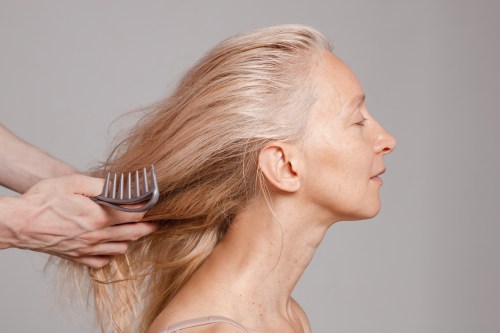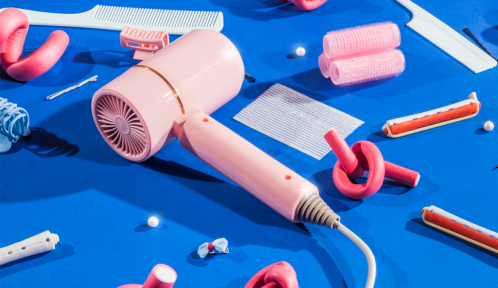Our editors independently select these products. Making a purchase through our links may earn Well+Good a commission
Yes, too much dry shampoo is *definitely* a thing—here’s when to put down the bottle
According to hair-care professionals, your quick-fix hack for faking clean hair (aka using too much dry shampoo) can easily backfire.

We’ve all been there: you’re two days post-wash and your scalp is starting to stink. Forget the full-blown lather and rinse—you grab some dry shampoo and with a single spritz, the situation is fixed. But then, you do the same thing on day three. And day four. And by day five, while your blowout may appear to be intact, your head is caked in layer upon layer of product. And according to pros, your quick-fix hack for faking clean hair (aka using too much dry shampoo) can easily backfire.
While dry shampoo is a great way to extend the life of your wash, you should think of it more as a bandaid than an actual treatment. “Dry shampoo does not remove debris or build up on the hair or scalp, but rather serves an aesthetic cleanse to maintain volume and bounce,” says trichologist and colorist Bridgette Hill with Paul Labrecque Salon and Skincare Spa. Though it may make your scalp look (and smell) clean, the more you use it the dirtier it gets.
“It’s almost like a perfect storm happens: you have four days of oil and then you load it up with powder or starch and then leave it sitting there so that it becomes like a clay,” says Dove celebrity stylist Mark Townsend. “This winds up forming a barrier on your scalp, and it just keeps absorbing more and more oil and winds up making your scalp look like its flaking.”
What can happen if you use too much dry shampoo?
Using too much dry shampoo has not-so-great effects on both your scalp and strands—some of which you may not even notice at first. “Build up of the dry shampoo can trap unwanted bacteria and create unhealthy yeast leading to developing abnormal scalp conditions, and the product build up slows down cellular turn over and distribution of nutrients which weaken the hair follicles,” says Hill. When your individual hairs become coated in dry shampoo, it can cause a waxy buildup, which leads to dryness and breakage because it blocks out moisture from adhering to the hair fiber. “Piling on the dry shampoo and not properly removing it can cause dandruff and the hair to weaken,” says Nine Zero One senior stylist Shaylee Blatz.
In addition to the issues it can cause on top of your head, piling on dry shampoo may also create problems for the skin on your face. “If you’re sleeping and you roll over, those powders transfer from your scalp to your pillow and then from your pillow onto your face,” says Townsend. And yes—it can also clog your pores.
How to know when you’ve gone too far with dry shampoo
Though you can usually start to feel it when you’ve gone too far with the dry shampoo, pros say you’ll know you’ve hit your limit when your hair starts to feel dry and gritty, or when there’s a noticeable white cast every time you apply it. “When dry shampoo is overused, your hair will not move or feel like hair, and will look and dull and dirty, completely opposite of the result a great dry shampoo should provide,” says Hill.
“Physical evidence that you’ve used too much is when the powder and the physical oils from your scalp combine together and turn into a sort of crud, where it looks like your scalp is flaking” says Townsend. And if you see any sort of chalky buildup, it means it’s time for a real shampoo and conditioning session.
How to keep your scalp clean
Whether you’re dealing with a day’s worth of dry shampoo or a week’s, it’s important to practice proper scalp hair to get it all off every time you wash. “Pre-treat the scalp by massaging a detoxifying essential oil, like frankincense, citrus, ylang ylang, into dry hair before you shampoo, which helps to break down and loosen the remnants of the dry shampoo remaining on the scalp,” says Hill. If you’ve got a lot of buildup, she suggests letting the oils sit overnight so that they can penetrate more deeply. Scalp scrubs, like Drunk Elephant T.L.C. Happi Scalp Scrub ($36), can also help break down leftover product buildup.
When you do shampoo, be sure to apply product directly to your scalp. “When shampooing, make sure to wash the hair twice and scrub at the root to ensure it is all gone,” says Blatz. The golden rule? “Until the hair feels clean and not gritty, keep washing.”
Best practices for using dry shampoo
Aside from treating yourself to regular washes as needed, applying dry shampoo the right way can help you avoid that cruddy buildup. The trick, according to Townsend, is to make sure that the product doesn’t sit on top of your scalp. “If you want a full cleanse without getting in the shower, make sure you’re holding the can a good 8-10 inches away from your scalp so that the powders have a chance to dry before they hit the scalp,” he says. Let it sit for 10-15 seconds, massage your scalp the way you would if you were shampooing your hair, and then brush it out.” This way, the powders and starches in the product will absorb the sebum (aka grease) from your scalp, and you’ll be able to brush them away and leave the scalp and the hair clean.
Another easy fix? Just apply your dry shampoo to your brush (instead of directly to your head) and comb it through your hair. “Get a mixed-bristle brush, like the Harry and Josh Premium Oval Brush ($50), and coat it with dry shampoo and brush down starting from the roots,” says Townsend. “That way, you’re doing it all in one step—you’re cleaning your hair and your scalp without getting any of the buildup from the dry shampoo.”
And of course, be sure to pick the right product. Townsend is a fan of Dove Clarifying Charcoal Dry Shampoo ($5), which is made with charcoal to help remove impurities from your scalp, and you can’t go wrong with Living Proof’s cult-favorite Perfect Hair Day Dry Shampoo ($25).
Sign Up for Our Daily Newsletter
Get all the latest in wellness, trends, food, fitness, beauty, and more delivered right to your inbox.
Got it, you've been added to our email list.










